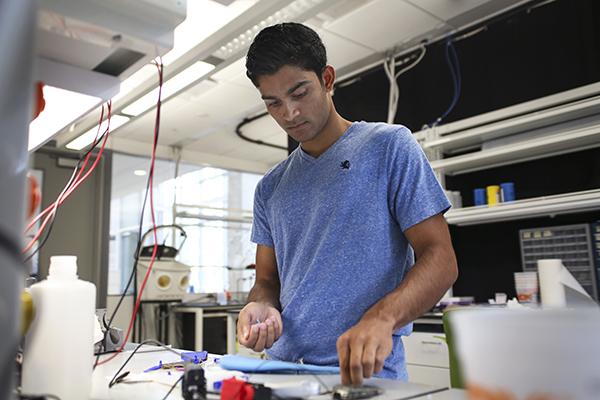Students are heading to the Smithsonian’s National Zoo for more than the pandas.
Students in the School of Engineering and Applied Science have been researching under Megan Leftwich, an assistant professor of mechanical and aerospace engineering, since 2013 to replicate the unique movement of sea lions – a research opportunity that students have been also been adding to their resumes.
The students are just some of the undergraduate research assistants who help professors, as officials have made research across GW a high priority.
Sea lions’ flippers propel themselves in a way that is undetectable, a key feature that could help researchers observe aquatic life without disrupting the environment.
Rahi Patel, a junior majoring in mechanical engineering, began working with Leftwich over the summer. Rahi also helped create a more precise design of the artificial flipper.
“Typically, when research comes into your mind, a lot of people think it’s slow and tedious and boring, but this project is not that,” Patel said. “It’s a lot of fun working with sea lions. We get to go to the zoo, and get to play with cool materials and things like that.”
The sea lion research effort is just one of Leftwich’s current projects, which includes another focused on wind farm design, according to her GW website.
Mattie Watson, a sophomore majoring in mechanical engineering, began working with Leftwich last year after the professor gave a presentation to Watson’s introductory engineering class. Now, Watson reviews videos of the sea lions that the research group is studying, which are located at the National Zoo.

Watson said she’s taken a few trips to the National Zoo with Leftwich to check up on the sea lions.
“[Leftwich’s] kids always come to the zoo with us, and they’re like the two cutest little boys ever,” she said. “One came wearing a Batman costume one time, and I almost died. He had the cape and everything. It was really cute.”
Josh Waldron, a senior majoring in mechanical engineering, said he got involved with Leftwich’s sea lion research project the summer after his sophomore year because he wanted to get research experience – an opportunity students can’t necessarily get from their classes. He no longer works with Leftwich in order to take research positions outside GW.
He was one of the first students to work with Leftwich, and used microscopes to analyze the surface of a sea lion’s flipper. He also helped Leftwich analyze skin samples to better understand how the flippers work.
Waldron added that he was interested in the part-time research position because he transferred from the Columbian College of Arts and Sciences to SEAS. He said he wanted to keep pace with other students who have had access to research opportunities for a year longer.
“Every time I’ve been interviewed, they always ask me about my extracurriculars outside of academics,” he said. “So you have to have academic experience, but you also have to have skills that complement that, which is research and other extracurriculars. It’s probably one of the most important things you can do as a scientist or engineer.”
Ryan Lasker contributed reporting.








